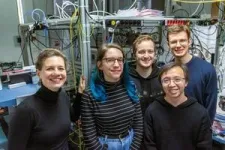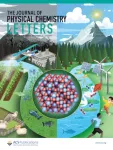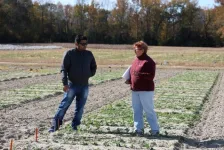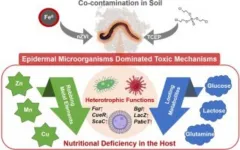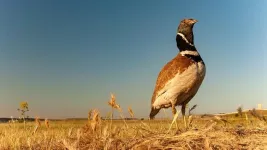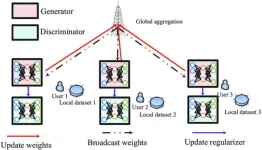(Press-News.org) The quantum ground state of an acoustic wave of a certain frequency can be reached by completely cooling the system. In this way, the number of quantum particles, the so-called acoustic phonons, which cause disturbance to quantum measurements, can be reduced to almost zero and the gap between classical and quantum mechanics bridged.
Over the past decade, major technological advances have been made, making it possible to put a wide variety of systems into this state. Mechanical vibrations oscillating between two mirrors in a resonator can be cooled to very low temperatures as far as the quantum ground state. This has not yet been possible for optical fibers in which high-frequency sound waves can propagate. Now researchers from the Stiller Research Group have taken a step closer to this goal.
In their study, recently published in Physical Review Letters, they report that they were able to lower the temperature of a sound wave in an optical fiber initially at room temperature by 219 K using laser cooling, ten times further than had previously been reported. Ultimately, the initial phonon number was reduced by 75%, at a temperature of 74 K, -194 Celsius. Such a drastic reduction in temperature was made possible by the use of laser light. Cooling of the propagating sound waves was achieved via the nonlinear optical effect of stimulated Brillouin scattering, in which light waves are efficiently coupled to sound waves. Through this effect, the laser light cools the acoustic vibrations and creates an environment with less thermal noise which is, to an extent, "disturbing" noise for a quantum communication system, for example. "An interesting advantage of glass fibers, in addition to this strong interaction, is the fact that they can conduct light and sound excellently over long distances," says Laura Blázquez Martínez, one of the lead authors of the article and a doctoral student in the Stiller research group.
Most physical platforms previously brought to the quantum ground state were microscopic. However, in this experiment, the length of the optical fiber was 50 cm and a sound wave extending over the full 50 cm of the core of the fiber was cooled to extremely low temperatures. "These results are a very exciting step towards the quantum ground state in waveguides and the manipulation of such long acoustic phonons opens up possibilities for broadband applications in quantum technology," according to Dr. Birgit Stiller, head of the quantum optoacoustics group.
Sound, in the day-to-day classical world, can be understood as a density wave in a medium. However, from the perspective of quantum mechanics, sound can also be described as a particle: the phonon. This particle, the sound quantum, represents the smallest amount of energy which occurs as an acoustic wave at a certain frequency. In order to see and study single quanta of sound, the number of phonons must be minimized. The transition from the classical to quantum behavior of sound is often more easily observed in the quantum ground state, where the number of phonons is close to zero on average, such that the vibrations are almost frozen and quantum effects can be measured. Stiller: "This opens the door to a new landscape of experiments that allow us to gain deeper insights into the fundamental nature of matter.” The advantage of using a waveguide system is that light and sound are not bound between two mirrors, but propagating along the waveguide. The acoustic waves exist as a continuum – not only for certain frequencies – and can have a broad bandwidth, making them promising for applications such as high-speed communication systems.
“We are very enthusiastic about the new insights that pushing these fibers into the quantum ground state will bring”, emphasizes the research group leader. “Not only from the fundamental research point of view, allowing us to peek into the quantum nature of extended objects, but also because of the applications this could have in quantum communications schemes and future quantum technologies”.
END
Towards the quantum of sound
2024-01-18
ELSE PRESS RELEASES FROM THIS DATE:
NFL PLAY 60 launches Fitness Tracking Competition to help students get daily minutes of movement
2024-01-18
DALLAS, January 17, 2024 — The American Heart Association and National Football League are asking classrooms, afterschool programs and other student groups to join the NFL PLAY 60 Fitness Tracking Competition from Jan. 22 to Feb. 9. The classroom with the most activity minutes in each of the 32 NFL club markets will receive a $1,000 grant with an additional $1,000 PLAY 60 grant awarded to the top classroom overall. The competition and the goal of NFL PLAY 60 is to increase physical activity in kids which impacts overall mental and physical wellness which is essential to help children reach their full potential.
The NFL PLAY 60 Fitness Tracking Competition takes place ...
Using magnetized neurons to treat Parkinson’s disease symptoms
2024-01-18
Electrical deep brain stimulation (DBS) is a well-established method for treating disordered movement in Parkinson’s disease. However, implanting electrodes in a person’s brain is an invasive and imprecise way to stimulate nerve cells. Researchers report in ACS’ Nano Letters a new application for the technique, called magnetogenetics, that uses very small magnets to wirelessly trigger specific, gene-edited nerve cells in the brain. The treatment effectively relieved motor symptoms in mice without damaging surrounding ...
How does one species become many?
2024-01-18
Evolutionary biologists have long suspected that the diversification of a single species into multiple descendent species – that is, an “adaptive radiation” – is the result of each species adapting to a different environment. Yet formal tests of this hypothesis have been elusive owing to the difficulty of firmly establishing the relationship between species traits and evolutionary “fitness” for a group of related species that recently diverged from a common ancestral species.
A global team of biologists led by McGill University have compiled nearly two decades of field data – representing the study ...
St. Jude Children’s Research Hospital adds $13 million project to Research Collaboratives Program
2024-01-18
(MEMPHIS, Tenn., January 18, 2024) St. Jude Children’s Research Hospital today announced a nearly $13 million investment toward a new research collaboration with scientists at Columbia University, Duke University and Stanford University to expand the understanding of G-protein coupled receptors (GPCR), which are vital proteins that impact human health and disease.
The collaborative research project is led by two St. Jude researchers, Scott Blanchard, Ph.D., and M. Madan Babu, Ph.D., who are working with Nobel laureate and Howard Hughes Medical Institute investigator Robert Lefkowitz, M.D., of Duke University; Jonathan Javitch, M.D., Ph.D., of ...
Efficiently moving urea out of polluted water is coming to reality
2024-01-18
WPI Researchers have developed a material to remove urea from water and potentially convert it into hydrogen gas. By building these materials of nickel and cobalt atoms with carefully tailored electronic structures, the group has unlocked the potential to enable these transition metal oxides and hydroxides to selectively oxidize urea in an electrochemical reaction.
The study, led by Xiaowei Teng, the James H. Manning professor of Chemical Engineering at WPI, was recently published in the Journal of Physical Chemistry Letters and highlighted in the publication’s supplementary front cover.
The ...
Researchers awarded $2.7 million grant to develop the faba bean as a sustainable mid-Atlantic crop
2024-01-18
Consider the faba bean, also known as the fava bean or broad bean.
The bright-green legume has been enjoyed as a diet staple for thousands of years in Africa, Asia, and the Mediterranean. Just one cup of faba beans has 13 grams of protein — making it a better protein source than most other legumes — along with plenty of fiber, potassium, and iron. Plus, it’s a good cover crop that helps improve soil health, slow erosion, and control pests, disease, and weeds.
But you don’t often see it in the fields or on the menus in Virginia.
That’s why College of Agriculture and Life ...
Cobalt-free batteries could power cars of the future
2024-01-18
CAMBRIDGE, MA – Many electric vehicles are powered by batteries that contain cobalt — a metal that carries high financial, environmental, and social costs.
MIT researchers have now designed a battery material that could offer a more sustainable way to power electric cars. The new lithium-ion battery includes a cathode based on organic materials, instead of cobalt or nickel (another metal often used in lithium-ion batteries).
In a new study, the researchers showed that this material, which could be produced at much lower cost than cobalt-containing batteries, can conduct electricity at similar rates as cobalt batteries. The new battery also has comparable storage ...
New study reveals the impact of skin microorganisms on earthworm toxicity in polluted environments
2024-01-18
Epidermal microorganisms, vital in nutrient exchange between hosts and environments, have now been shown to play a key role in host toxicity through community changes. This research highlights how changes in the community of skin-based microbes correlate more significantly with earthworm toxicity than those in intestinal microorganisms, especially under combined soil contaminations.
A new study (https://doi.org/10.1016/j.eehl.2023.11.001) published in the journal Eco-Environment & Health, researchers from Zhejiang University revealed the crucial role of epidermal microorganisms in influencing earthworm toxicity under environmental stress, notably in conditions ...
Scientists, farmers and managers work together to avoid the decline of the little bustard, an endangered steppe bird
2024-01-18
The collaboration between scientists, farmers and managers is crucial to improve the protection of the little bustard, an endangered steppe-land bird in Spain due to human activity. The reduction of natural habitats, the increase in irrigation and the urbanization of the land have led to having less surface areas that guarantee the survival of this vulnerable species. An article published in the journal Biological Conservation reveals how cooperation between different actors is key to finding answers and avoiding the decline of the most threatened populations of the little bustard.
The study, a pioneer example of adaptative conservation, ...
Better wireless communication made possible through machine learning
2024-01-18
In today's increasingly interconnected world, high-quality communication has become more vital than ever. Accurately estimating the dynamic status of communication channels is a key factor in achieving this. Recently, a joint research team designed a new algorithm that offers high-level estimation accuracy and privacy protection with low computational and communication costs. This research was published Jan. 5 in Intelligent Computing, a Science Partner Journal.
This new algorithm uses a specially designed deep learning model for precise estimation and a federated learning framework ...

